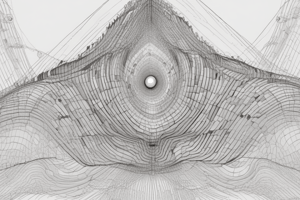Podcast
Questions and Answers
What are fixed-end moments?
What are fixed-end moments?
- Moments that result from external loads applied at midspan.
- Moments caused by the thermal expansion of a member.
- Moments that occur when a member is fixed at both ends. (correct)
- Moments that occur when a member is free to rotate at both ends.
What is the purpose of distribution factors in the Moment Distribution Method?
What is the purpose of distribution factors in the Moment Distribution Method?
- To compute the shear forces acting in the structure.
- To evaluate the stability of the entire frame under load.
- To calculate the total deflection of the structure.
- To determine how moments are shared among different members based on their stiffness. (correct)
During the Moment Distribution Method, what should be done after distributing the moments?
During the Moment Distribution Method, what should be done after distributing the moments?
- Apply carry-over moments to the other end of the member. (correct)
- Directly apply external loads to determine reactions.
- Stop the calculation as the results are final.
- Calculate the total moments acting on the entire structure.
When applying the Slope Deflection Method, what are Slope-Deflection Equations used for?
When applying the Slope Deflection Method, what are Slope-Deflection Equations used for?
In the process of iterating in the Moment Distribution Method, what is the goal?
In the process of iterating in the Moment Distribution Method, what is the goal?
Which of the following is true when considering multibay, multistoried portal frames under symmetric loads?
Which of the following is true when considering multibay, multistoried portal frames under symmetric loads?
What does a carry-over moment represent in the context of the Moment Distribution Method?
What does a carry-over moment represent in the context of the Moment Distribution Method?
In the Moment Distribution Method, how is the distribution factor ($DF_i$) calculated for each member?
In the Moment Distribution Method, how is the distribution factor ($DF_i$) calculated for each member?
Which method is particularly effective for analyzing frames experiencing sway?
Which method is particularly effective for analyzing frames experiencing sway?
How does symmetry affect the analysis of multistoried frames in the Moment Distribution Method?
How does symmetry affect the analysis of multistoried frames in the Moment Distribution Method?
What is represented by the term $EI$ in the slope-deflection equations?
What is represented by the term $EI$ in the slope-deflection equations?
Which step should be performed first in the slope-deflection method?
Which step should be performed first in the slope-deflection method?
How does side sway influence the analysis of portal frames in the slope-deflection method?
How does side sway influence the analysis of portal frames in the slope-deflection method?
What do $M_{AB}$ and $M_{BA}$ represent in the slope-deflection equations?
What do $M_{AB}$ and $M_{BA}$ represent in the slope-deflection equations?
What should be calculated after determining moments and rotations in the slope-deflection method?
What should be calculated after determining moments and rotations in the slope-deflection method?
To analyze a structure using the slope-deflection method, which aspect is not crucial?
To analyze a structure using the slope-deflection method, which aspect is not crucial?
What is the primary advantage of applying the slope-deflection method?
What is the primary advantage of applying the slope-deflection method?
In the equation $M_{AB} = \frac{EI}{L} \left( 2\theta_A + \theta_B \right) + M_{fixed}$, what does $L$ represent?
In the equation $M_{AB} = \frac{EI}{L} \left( 2\theta_A + \theta_B \right) + M_{fixed}$, what does $L$ represent?
Why is it important to apply boundary conditions in the slope-deflection method?
Why is it important to apply boundary conditions in the slope-deflection method?
Which equation correctly relates the moments at ends A and B considering the rotations?
Which equation correctly relates the moments at ends A and B considering the rotations?
Flashcards are hidden until you start studying
Study Notes
Moment Distribution Method
- A classical method used in structural analysis to determine moments and shear forces in indeterminate structures, particularly useful for frames and continuous beams.
- Utilizes fixed-end moments, distribution factors, and carry-over moments.
- Fixed-End Moments: Moments that occur at the ends of a member if it were fixed at both ends.
- Distribution Factors: Proportion of the moment each member carries based on its relative stiffness.
- Carry-Over Moments: The moment transferred from one end of a member to the other when connected to another member.
- Steps:
- Calculate fixed-end moments for each member.
- Determine distribution factors for each joint based on relative stiffness.
- Distribute moments based on distribution factors.
- Apply carry-over moments to the other end of the member.
- Repeat distribution and carry-over processes until moments stabilize.
- Applicable to multibay and multistoried symmetrical frames subjected to symmetric loads, accounting for sway due to lateral loads.
- Calculations can be simplified using symmetry.
Slope Deflection Method
- Another classical method for analyzing indeterminate structures, effective for frames experiencing rotations (sway).
- Utilizes slope-deflection equations that relate end moments of a member to rotations and displacements.
- Steps:
- Determine fixed-end moments for each member.
- Write slope-deflection equations for each member considering end moments and rotations.
- Apply boundary conditions to simplify equations.
- Solve the equations simultaneously to find rotations and moments.
- Calculate reactions and internal forces based on moments and rotations.
- Applicable to portal frames subjected to side sway, where lateral displacement of joints and rotations must be considered in slope-deflection equations.
- Analyzing each frame member while tracking side sway's influence is critical for stability and moment distribution.
Conclusion
- The Moment Distribution and Slope Deflection Methods are fundamental for analyzing portal frames under various loading conditions.
- They enable engineers to calculate moments, shear forces, and deflections, ensuring structural safety and stability.
- These methods can address symmetric and asymmetric loading conditions, accounting for sway in portal frames.
Studying That Suits You
Use AI to generate personalized quizzes and flashcards to suit your learning preferences.





